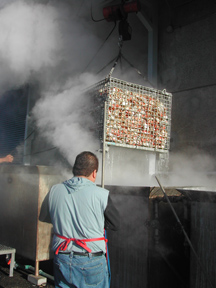From the start of the ’04/’05 crab season,the catch has been excellent. During the months of February and March, Crab Fests are being hosted all around the San Francisco Bay Area. The biggest Crab Fest is being held at Fisherman’s Wharf in San Francisco, and everyone is invited.

Killer Crab available at the Crab House on Pier 39 or the Dead Fish in Crockett is a classic example of a heavenly way to eat crab.
Published: February, 2005
From the start of the ’04/’05 crab season,the catch has been excellent. During the months of February and March, Crab Fests are being hosted all around the San Francisco Bay Area. The biggest Crab Fest is being held at Fisherman’s Wharf in San Francisco, and everyone is invited. The Fisherman’s Wharf Business Association is sponsoring a number of special events all around the Wharf area and participating local restaurants are offering mouth-watering crab special dishes during the month of February to encourage visitors and locals alike to come and enjoy the succulent bounty of the sea. Dungeness Crab is a symbol of San Francisco.
When the crab season started at midnight on November 15th, local and visiting boats rushed out to the Bay. The rolling ball of migrating crab was not hard to locate off San Francisco’s coast. Within 23 hours, crab started rolling in, by the thousands. For the first 10-12 days of the season, huge numbers were brought in by large visiting vessels. These vessels roam the western coastal seas. Visiting fishermen come to Bay Area waters from Alaska, Washington, Oregon, and other California harbors. It is a dangerous and hard life. We were lucky to meet some of these visitors as they passed through our Bay.
Captain Dennis Sturgell of Bold Contender is considered a top skipper among this group of crab fishing fleets. His home port is in Oregon. Captain Dennis and his crew were excited about their good luck at the start of the crab season. They filled the vessel’s 60,000-lb. hold until it was brimming with their first catch of the new season by the wee hours of Saturday morning, November 17th. A call home as they began to pull the last round of traps in brought the wives of Captain Dennis and crewman Jeremy Hammond to the San Francisco docks by plane and cab to welcome their men to port.
Bold Contender’s crab catch was sold before they docked. It took a long time to offload such a large amount of crab into a variety of buyers’ carry crates. As they neared the bottom of the hold, compression from the weight of the upper layers of 45,000 lb. of crab made the bottom 15,000 lbs. move slowly. The hold was filled with circulating cold seawater from the harbor to revitalize the remaining crab from the press.
Jeremy recently purchased a 58’ vessel similar to Bold Contender. While outfitting it, and applying for coveted permits, he fishes with Captain Dennis. When asked how he got started, he said he was home schooled aboard his Dad’s boat when he was very young. His Dad was a Berring Sea captain, he explained with a proud grin. “Fishing is freedom. The sea is the only place I don’t feel claustrophobic. Nothing can hurt me, except myself. It is just me, the ocean, and my crew.” His goal to be a Berring Sea fisherman like his Dad will have to wait. That area is now open just two weeks a year. The big boats took too many at once before limits were set to keep the sea healthy. The extremely short season is designed to allow those schools of fish a chance to recover, which will take years. When it does, Jeremy will be ready and waiting to carry on. The other crew members also started just out of school with their Dads. It gets in your blood, they all said with grins. “I don’t relax, till we cast off,” finished Jeremy.
“Big boats,” said Steve Turner, representing one of the wholesale buying and selling firms on the docks, “are closely managed.” They bring in a lot of money to the community for their catch. They follow the migrating crab north and don’t stay long in any one spot. They leave resident crab for the resident fleet. Next stop this year is most likely Oregon, then Washington and on to Alaska. Their crab season, like for our local fishermen, is eight months long, filled in with other types of fishing to make theirs a year-round job.
Steve said he has noticed a change in the crab since the big boats started working our waters. He thought perhaps the outer water’s salinity and/or algae the crab eat has changed. Last year, and again this year, their shells are softer than the first few years. Crab coming in are of good size. Those caught, and kept, meet the minimum of 6-1/4 inches from horn to horn and are all male. Females are returned to the sea. There’s no question that they taste great, but they do not stand up to the compression of big holds like before. The boats race to get their catches in quickly to avoid loss. While the crab in the bottom of Bold Contender’s hold took a swim, Captain Dennis and crewman Jeremy enjoyed a chance to visit with their ladies, and to try a few of the hundreds of chocolate chip cookies they and their kids had made for their men to take along for the next part of their voyage.
The dockside cookers billowed steam in the cold morning air. Bin after bin of crab were immersed in steaming hot waters to cook on the docks. These crab were for better restaurants and markets nearby. The Fisherman’s Wharf crab fleet get crab to the table at its peak of freshness and flavor.



